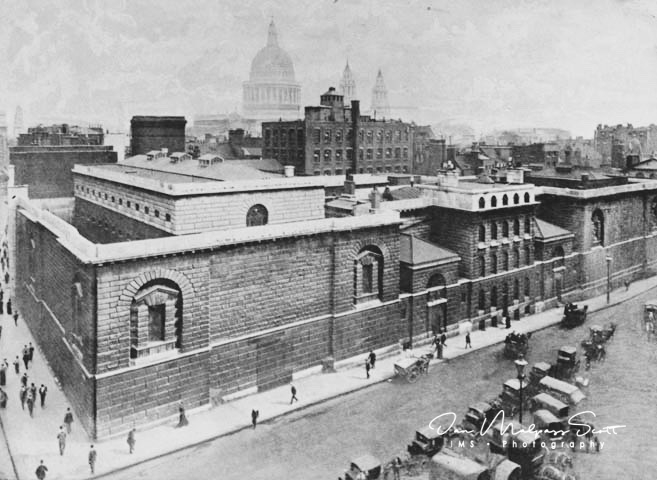
Newgate Prison was a prison in London, at the corner of Newgate Street and Old Bailey just inside the City of London. It was originally located at the site of Newgate, a gate in the Roman London Wall. The gate/prison was rebuilt in the 12th century, and demolished in 1904. The prison was extended and rebuilt many times, and remained in use for over 700 years, from 1188 to 1902.
The first prison at Newgate was built in 1188 on the orders of Henry II. It was significantly enlarged in 1236, and the executors of Lord Mayor Dick Whittington were granted a license to renovate the prison in 1422. The prison was destroyed in the Great Fire of London in 1666, and was rebuilt in 1672, extending into new buildings on the south side of the street.
According to medieval statute, the prison was to be managed by two annually elected Sheriffs, who in turn would sublet the administration of the prison to private “gaolers”, or “Keepers”, for a price. These Keepers in turn were permitted to exact payment directly from the inmates, making the position one of the most profitable in London. Inevitably, the system offered incentives for the Keepers to exhibit cruelty to the prisoners, charging them for everything from entering the gaol to having their chains both put on and taken off. Among the most notorious Keepers in the Middle Ages were the 14th-century gaolers Edmund Lorimer, who was infamous for charging inmates four times the legal limit for the removal of irons, and Hugh De Croydon, who was eventually convicted of blackmailing prisoners in his care.
Over the centuries, Newgate was used for a number of purposes including imprisoning people awaiting execution, although it was not always secure: burglar Jack Sheppard escaped from the prison two times before he went to the gallows at Tyburn in 1724. Prison chaplain Paul Lorrain achieved some fame in the early 18th century for his sometimes dubious publication of Confessions of the condemned.
Parliament having granted £50,000 towards the cost, the City of London provided a piece of ground 1,600 feet (500 m) long and 50 feet (15 m) deep to enlarge the site of the prison and to build a new sessions house. The work was begun in 1770 to the designs of George Dance. The new prison was almost finished when it was stormed by a mob during the Gordon riots in June 1780. The building was gutted by fire, and the walls badly damaged. The cost of repairs was estimated at £30,000. Dance’s new prison was finally completed in 1782.
The new prison was constructed to an architecture terrible design intended to discourage law-breaking. The building was laid out around a central courtyard, and was divided into two sections: a “Common” area for poor prisoners and a “State area” for those able to afford more comfortable accommodation. Each section was further sub-divided to accommodate felons and debtors.
The prison closed in 1902, and was demolished in 1904. The Central Criminal Court (also known as the Old Bailey after the street on which it stands) now stands upon its site.
The original door from a prison cell used to house St. Oliver Plunkett in 1681 is on display at St. Peter’s Church in Drogheda, Ireland. The original iron gate leading to the gallows was used for decades in an alleyway in Buffalo, New York, USA and is currently housed in that city at Canisius College.
Built: 1702
Demolished: 1904
Architect: George Dance


